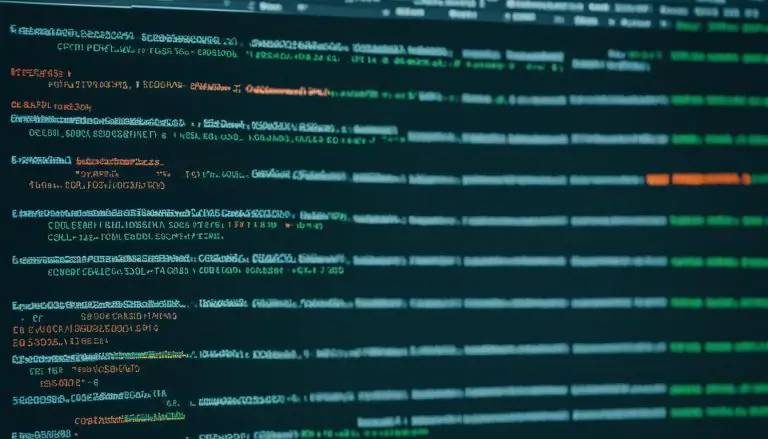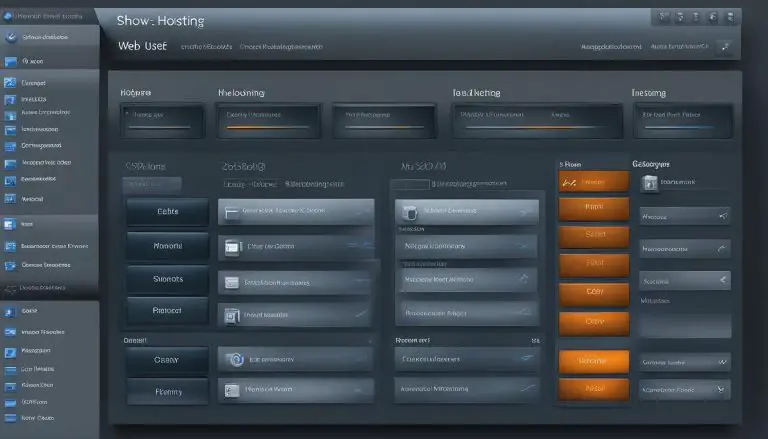In a Nutshell: What is Debugging Explained Simply
Debugging is a crucial process in software development that involves identifying and resolving issues in code. It ensures that programs function correctly and meet user expectations. Understanding the debugging process and the tools available is essential for developers to deliver high-quality software solutions.
Key Takeaways:
- Debugging is a multistep process that involves identifying and resolving issues in software code.
- The process includes identifying the problem, finding the source of the error, and using various debugging tools to correct the issue.
- Debugging is crucial for maintaining software quality and ensuring that programs function as intended.
- Common coding errors, such as syntax errors, runtime errors, semantic errors, and logic errors, require debugging to resolve.
- Developers can use various strategies and tools, such as source code analyzers, print debugging, and simulators, to efficiently resolve errors.
The Importance of Debugging in Software Development
Debugging plays a vital role in software development, ensuring that software programs function as intended. Despite careful coding, errors or bugs can still occur, making debugging an essential process. It is an integral part of the software testing phase and the overall software development lifecycle.
“Debugging is like being the detective in a crime movie where you are also the murderer.” – Filipe Fortes
Software errors can have a significant impact on the performance and reliability of a program. By conducting thorough debugging, developers can identify and resolve these errors before they reach end-users. Debugging allows developers to deliver high-quality software that meets user expectations and provides a seamless user experience.
Software testing is incomplete without proper debugging. It helps ensure that all code is thoroughly analyzed, and potential issues are addressed, resulting in more stable and reliable software applications. Debugging enables developers to identify the root causes of errors and make the necessary optimizations to enhance software efficiency.
Software Testing and Debugging: A Symbiotic Relationship
Software testing and debugging go hand in hand, working together to identify and eliminate errors. Through rigorous testing, developers can identify potential issues and bugs. Once these issues are identified, the debugging process allows for a systematic approach to locating and fixing errors. By combining these two processes, developers can enhance the overall quality of their software and optimize its performance.
The Debugging Process in Software Development
The debugging process in software development is a critical and systematic approach to identifying and resolving code errors. It plays a crucial role in ensuring the functionality and reliability of software applications. The process involves multiple stages, starting with the identification of the problem and then analyzing the code to locate the exact source of the error.
Developers use various techniques and tools to facilitate the debugging process. One commonly used technique is setting breakpoints, which allows developers to pause the program’s execution at specific points and examine the state of variables and memory. This helps in identifying and understanding the flow of the code and pinpointing the error.
Other debugging tools, such as stand-alone debuggers and integrated development environments (IDEs) with debugging capabilities, are also employed to assist in error identification and resolution. These tools provide features like stepping through the code line by line, examining variable values, and evaluating expressions. Additionally, developers may utilize debug modes in IDEs or use print statements to trace the execution of the code and monitor its behavior.
The debugging process in software development requires a systematic and methodical approach. It is an iterative process that involves identifying code errors, analyzing the code, and using appropriate tools and techniques to locate and resolve the errors. By effectively navigating the debugging process, developers can ensure the delivery of high-quality software applications.
Common Coding Errors that Require Debugging
When it comes to coding, errors can occur at various stages of development. These errors, if left undetected, can lead to software malfunctions and hinder the overall performance of the program. Understanding the common coding errors that require debugging is essential for developers to ensure the smooth functioning of their software applications.
In the realm of coding, one of the most common errors is the syntax error. Syntax errors occur when there is a mistake in the code’s syntax, preventing it from compiling or running correctly. Such errors can range from simple typographical mistakes to more complex structural inconsistencies that violate the language’s syntax rules.
Another type of error that developers often encounter is the runtime error. Runtime errors occur when the program encounters an error during execution, such as insufficient memory or a stack overflow. These errors are not detected during the compilation process and can cause the program to crash or behave unexpectedly.
Semantic errors and logic errors are two other common coding errors that require debugging. A semantic error occurs when there is a mistake in the logic or meaning of the code. This type of error does not result in a direct system crash but can cause incorrect calculations or unpredictable behavior. On the other hand, a logic error refers to flaws in the step-by-step process or algorithm of the program, leading to incorrect outputs or unexpected results.
| Error Type | Description |
|---|---|
| Syntax Error | Mistakes in code syntax that prevent compilation or execution |
| Runtime Error | Errors that occur during program execution |
| Semantic Error | Mistakes in the logic or meaning of the code |
| Logic Error | Flaws in the step-by-step process or algorithm of the program |
Debugging Strategies for Efficient Error Resolution
When it comes to debugging software applications, developers employ various strategies to efficiently resolve errors. These strategies help pinpoint and fix coding issues more effectively, ensuring the development of high-quality software. Some commonly used debugging strategies include:
-
Source Code Analyzers
Source code analyzers are tools that assist developers in identifying common code errors. They analyze the code and provide insights into potential issues that may cause errors. By using source code analyzers, developers can proactively detect and resolve coding issues, improving the overall quality of their software.
-
Static Analysis
Static analysis involves examining the code without executing the program. It helps identify potential errors such as syntax mistakes, uninitialized variables, and unreachable code. By analyzing the code statically, developers can catch errors early in the development process, saving time and effort in debugging later on.
-
Print Debugging
Print debugging, also known as tracing, is a debugging technique where developers insert print statements in their code to monitor its execution. These print statements provide valuable information about the program’s flow and the values of variables at different stages. By analyzing these print statements, developers can trace the cause of errors and resolve them more efficiently.
-
Remote Debugging
Remote debugging allows developers to debug a program running on a different system or environment. This is particularly useful when dealing with distributed systems or debugging issues that occur in specific deployment scenarios. By remotely debugging the application, developers can identify and resolve errors in real-time, even if the application is running in a different location.
By employing these debugging strategies, developers can streamline the error resolution process and deliver robust software applications.
Essential Debugging Tools for Software Developers
When it comes to debugging code, having the right tools can make all the difference. As a software developer, I rely on a variety of debugging tools to identify and fix errors in my code efficiently. These tools range from debuggers and code analysis tools to simulators, each serving a specific purpose in the debugging process.
Debugger
A debugger is a crucial tool that allows developers to analyze their code and track the execution of their program. With a debugger, I can set breakpoints in my code, examine variables and memory, and step through each line to pinpoint the source of an error. It provides valuable insights into the state of the program during runtime and helps me understand the flow of execution.
Code Analysis Tools
Code analysis tools are another essential asset in the debugging toolkit. These tools help identify common coding errors, such as syntax mistakes or potential security vulnerabilities. By analyzing the code without executing the program, I can catch errors early on and ensure the code adheres to best practices. Security analyzers and complexity analyzers are examples of code analysis tools that provide valuable feedback on the quality of the code.
Simulators
In certain cases, it’s important to understand how an application will behave on different operating systems or computing devices. Simulators allow me to replicate various environments and test my code under different conditions. This helps identify any platform-specific issues or compatibility problems that may arise. By using simulators, I can ensure that my code functions correctly across different platforms, delivering a seamless user experience.
Overall, these debugging tools empower me as a software developer to detect and resolve errors efficiently. Whether it’s using a debugger to analyze the program’s execution, leveraging code analysis tools to catch common errors, or utilizing simulators to test different environments, these tools are essential for delivering high-quality software.
Challenges Faced in the Debugging Process
The debugging process can present several challenges for developers. From error identification to error reproduction, each step requires careful attention and thorough debugging techniques. Some of the common challenges encountered during the debugging process include dealing with complex code, dependencies between code modules, and finding the exact source of an error.
Error identification is often the first hurdle in the debugging process. Developers need to pinpoint the exact location of the error, which can be challenging if the cause is not immediately clear. It requires thorough analysis of the code and understanding its intended functionality. Without a clear understanding of the problem, developers may spend valuable time debugging the wrong areas of the code.
Error reproduction is another challenge that developers face. In order to fix an error, it is crucial to be able to reproduce it consistently. This can be time-consuming and require detailed steps to replicate the problem. Without a reliable way to reproduce the error, it becomes difficult to identify the root cause and find an effective solution.
Complex code adds another layer of complexity to the debugging process. In large software programs with extensive codebases, it can be daunting to navigate through the vast amount of code and understand the interactions between different components. Each component may have its own set of dependencies and potential interactions, making it challenging to identify where the error originates and how it affects the overall functionality of the program.
Dependencies between code modules can introduce new errors during the debugging process. Fixing one problem may inadvertently create new issues in other parts of the codebase. This can be especially challenging when working with complex systems that have multiple interconnected modules. Developers need to carefully manage these dependencies while debugging to ensure that fixing one error does not create new ones.
The Challenges Faced in the Debugging Process:
- Error identification
- Error reproduction
- Complex code
- Dependencies
| Challenges Faced in the Debugging Process |
|---|
| Error identification |
| Error reproduction |
| Complex code |
| Dependencies |
The Origins of Debugging and its Significance
The term “debugging” originated from the work of Admiral Grace Hopper, a pioneer in computer programming. The term was inspired by an incident where a moth got stuck in the relays of a computer, causing a malfunction. Admiral Hopper and her team “debugged” the computer by removing the moth and solving the problem. This incident led to the use of the term “bug” to refer to errors or defects in software. Debugging became synonymous with the process of troubleshooting and fixing software errors. The origins of debugging highlight its significance in the field of computer programming.
“From a technical perspective, debugging is an art form but only engineers, artists, and those of similar ilk understand this.”
Debugging plays a vital role in the software development process, ensuring that programs function correctly and meet user expectations. By identifying and resolving errors in the code, developers can deliver high-quality software products that perform reliably. The significance of debugging lies in its ability to save time and resources by preventing software issues from reaching the end-users. It allows developers to catch and fix errors early in the development lifecycle, resulting in a smoother user experience and increased customer satisfaction.
| Debugging Significance | Explanation |
|---|---|
| Enhances software reliability | Debugging helps identify and fix errors, improving the overall stability and reliability of software applications. |
| Reduces development time | By addressing issues early in the development process, debugging reduces the time spent on bug fixing and software modifications. |
| Improves user satisfaction | Avoiding software errors through debugging ensures a smooth user experience and enhances customer satisfaction. |
Overall, the origins of debugging and its significance highlight the importance of this process in the field of computer programming. By understanding its roots and embracing modern debugging techniques and tools, developers can effectively resolve coding errors and deliver high-quality software solutions.
Debugging with AWS: Tools and Support
When it comes to debugging applications on the AWS platform, developers have access to a range of powerful tools and comprehensive support. One of the key tools offered by AWS is AWS X-Ray, which provides in-depth analysis of applications during development and production. With AWS X-Ray, developers gain valuable insights into application performance, identify root causes of issues, and expedite the troubleshooting process. This debugging tool is particularly useful for identifying bottlenecks, latency issues, and errors in distributed applications.

Another valuable resource for debugging with AWS is the availability of IDE plugins. These plugins, compatible with popular integrated development environments like Eclipse, enable developers to seamlessly debug cloud applications directly from their preferred IDE. This streamlined workflow saves developers time and effort by eliminating the need to switch between different tools and environments. With IDE plugins, developers can effortlessly debug their applications and quickly resolve any errors that arise.
Additionally, AWS provides support for remote debugging, allowing developers to debug applications running in separate environments. This is particularly useful when troubleshooting issues that only occur in specific environments or when debugging applications deployed on different instances. With remote debugging capabilities, developers can effectively diagnose and resolve errors without the need for direct access to the application’s environment.
In summary, AWS offers a comprehensive suite of tools and support for debugging applications. AWS X-Ray, IDE plugins, and remote debugging capabilities empower developers to efficiently identify, diagnose, and resolve errors throughout the development and production lifecycle. These debugging resources enhance the overall debugging process, enabling developers to deliver high-quality applications with improved performance and reliability.
The Future of Debugging: Advancements and Trends
As technology continues to evolve, the future of debugging holds exciting advancements and trends that promise to revolutionize the way we identify and resolve software errors. One such advancement is automated debugging, which aims to streamline the debugging process by automatically identifying and fixing common coding errors. With automated debugging tools, developers can save time and effort in manually hunting down and resolving bugs, allowing them to focus on more critical aspects of software development.
Machine learning and artificial intelligence (AI) are also playing a significant role in the future of debugging. Using advanced algorithms and data analysis techniques, machine learning can help improve error detection and resolution. By leveraging vast amounts of code and error data, AI-based debugging systems can learn to recognize patterns and suggest potential solutions for complex coding issues. This not only accelerates the debugging process but also enables developers to benefit from intelligent insights that may have otherwise been overlooked.
Incorporating machine learning and AI into the debugging process is not only limited to error resolution. These technologies can also assist in code optimization, performance analysis, and identifying potential security vulnerabilities. By continuously learning from the vast amount of data generated during software development, machine learning and AI-based debugging systems have the potential to greatly enhance the overall quality and reliability of software applications.
Table: Advancements in Debugging
| Advancement | Description |
|---|---|
| Automated Debugging | Streamlining the debugging process through automated identification and resolution of common coding errors. |
| Machine Learning | Improving error detection and resolution through advanced algorithms and data analysis techniques. |
| AI-based Debugging | Utilizing artificial intelligence to intelligently analyze code, suggest solutions, and optimize software applications. |
The future of debugging is undoubtedly exciting, as advancements in automated debugging, machine learning, and AI-based techniques will continue to transform the way we approach software development. As these technologies become more sophisticated and accessible, developers can expect a reduction in debugging time, improved software quality, and enhanced user experiences. By embracing these advancements, developers can stay at the forefront of the ever-evolving debugging landscape and deliver robust, high-performance software solutions.
Conclusion
In conclusion, debugging is a vital process in software development that involves identifying and resolving errors in code. By utilizing various debugging strategies and tools, developers can efficiently address coding errors and deliver high-quality software applications. The debugging process may present challenges, such as error identification and reproduction, complex code, and dependencies, but through thorough analysis and attention to detail, these challenges can be overcome. The origins of debugging, coined by Admiral Grace Hopper, highlight its significance and its evolution as a troubleshooting process in computer programming.
AWS provides developers with valuable tools and support for debugging applications, such as AWS X-Ray and remote debugging options. Furthermore, the future of debugging holds exciting advancements, including automated debugging and the integration of machine learning and AI techniques, which promise to streamline the error resolution process. As technology continues to advance, embracing these innovations will enhance developers’ debugging capabilities and enable the delivery of robust software solutions.
In summary, debugging plays a crucial role in software development, ensuring the functionality and reliability of applications. By employing effective debugging strategies, utilizing debugging tools, and staying up to date with emerging trends, developers can optimize their debugging process and deliver top-notch software products. Debugging is an ongoing process that evolves alongside technology, and by embracing its future advancements, developers can stay ahead of the curve and deliver exceptional software solutions.
FAQ
What is debugging?
Debugging is a multistep process that involves identifying and resolving issues in software. It is essential in software development to ensure that programs function correctly.
Why is debugging important in software development?
Debugging is crucial in software development as it helps identify and fix errors or bugs in the code. It ensures that the software functions as intended and delivers high-quality products.
How does the debugging process work?
The debugging process starts with identifying the problem, analyzing the code, and finding the exact location of the error. Various tools and techniques are used to correct the problem and test the solution.
What are common coding errors that require debugging?
Common coding errors include syntax errors, runtime errors, semantic errors, and logic errors. These errors can be challenging to identify and require debugging to resolve.
What are some strategies for efficient error resolution?
Developers use source code analyzers, static analysis, print debugging, and remote debugging to efficiently resolve errors during the debugging process.
What are essential debugging tools for software developers?
Debugging tools such as debuggers, code analysis tools, and simulators are essential for software developers to identify and fix errors in their code.
What challenges are faced in the debugging process?
Challenges in the debugging process include identifying the exact source of an error, reproducing the error consistently, debugging complex code, and dealing with dependencies between code modules.
What is the origin of the term “debugging” in software development?
The term “debugging” originated from Admiral Grace Hopper’s work, where a moth got stuck in a computer and caused a malfunction. This incident led to the use of the term “bug” to refer to errors or defects in software.
What debugging tools and support does AWS provide?
AWS provides developers with tools like AWS X-Ray for analyzing applications and plugins for popular IDEs. It also offers remote debugging capabilities to debug applications running in separate environments.
What is the future of debugging?
The future of debugging holds advancements in automated debugging tools, machine learning, and AI-based techniques to improve error detection and resolution in software applications.
What is the importance of debugging in software development?
Debugging is essential in software development to identify and resolve errors, ensuring the functionality and reliability of software applications.
- About the Author
- Latest Posts
Mark is a senior content editor at Text-Center.com and has more than 20 years of experience with linux and windows operating systems. He also writes for Biteno.com






